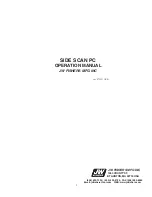
15
After the transmit pulse, the CPU generates a short delay* (to allow the transducers to settle ) and after the delay, it looks
at the output of the TVG circuit, and takes evenly spaced samples of the signal. The spacing between each sample pulse
is determined by the Range selected. The CPU sends the pieces of information to the display where each sample is
displayed on the screen. It is the amplitude of the samples of the received signal that determines the color displayed.
Targets # 1 and 2 above would display as a dark** color whereas the normal bottom return would print a light color on
the display. After displaying the line, all lines on the screen move down one to allow room for the next line.
While the above displaying took place, the CPU sent another transmit pulse to the fish. This sequence repeats itself for
as long as the side scan is turned on.
Each transmit pulse results in one line being displayed in each channel. Both channels are displayed simultaneously.
How often we transmit depends on the Range selected.
* This delay can be extended, by the operator, for water column removal (covered later).
** For ease of explanation, we will assume that the operator has selected “gray scale” for display colors. A soft
(low amplitude) return would display light gray and a hard (high amplitude) return would display a dark gray
(black).
A
m
p
l
i
t
u
d
e
Next transmit pulse
Transmit pulse
#1
#2
Shadow
Shadow
Delay
1624 Samples
Summary of Contents for SSS-100K PC
Page 51: ...51 Left Blank ...
Page 55: ...55 Left Blank ...


































